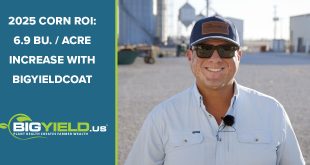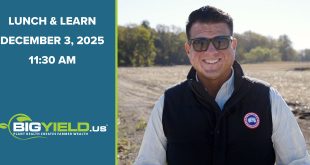
Kent Kauffman discusses broadcast burning and the benefits it brings to growers.
Listen to Kent Kauffman of the BigYield.us team and Kyle Hill, Ag 1280 Farm Director, each Monday, Wednesday, and Friday on Ag 1280 KDKD-AM. The segments air at 7:15 am and again at 12:15 pm.
This segment originally aired on May 15, 2017.
Audio Transcription
Kyle: Time once again for the BigYield Spotlight. I’m Kyle Hill visiting with Kent Kauffman of BigYield.us. Kent welcome back to the studio.
Kent: Thanks for having me Kyle.
Kyle: Now I’ve been hearing about growers in our area burning and flaming weeds. I’ve actually been driving past some fields where that has been taking place in the past few weeks. What can you tell us about this?
Kent: Well Kyle, burning and flaming weeds is basically where you’re running a flame-thrower through the field and using the heat to kill the weeds. What this heat does is it vaporizes the water in the plant cells, which then causes the weed to die. The flame is just a heat source, so you don’t actually have to char the weed. You can test whether the weed is going to die right after you go over it. Put your thumb on a leaf, and if you can see your fingerprint, then that weed should die within two to three days. You will see weed kill much faster than you would with conventional chemicals.
Kyle: So how are you using this in the field right now?
Kent: Right now we are broadcast burning. This basically means we are running a burner with flame-throwers all the way across. It’s like a conventional burn-down herbicide – we’re trying to kill off everything in the field. We’ve done this both before and after planting, and even after emergence in corn. What happens when you’re doing it, you’re trying to do it as late as possible in corn to get as good of weed control before you get canopy cover. You can do it before you have five leafs come out of the ground and that growth portion of the corn is still underground. We’ve had tremendous success with this so far this year. We have beautiful looking fields. When the growth portion comes out of the ground, then you’ll go to where we have row crop burning. This is where the growth portion just has to be above the flame, which we’ll talk about in another session.
Kyle: I understand you have this type of equipment available. What are the running costs on this equipment?
Kent: So the running costs are very reasonable, especially compared to conventional sprayers. Just the equipment itself is going to be 1/10th or less of the cost of a new sprayer. It has very low maintenance cost – you don’t have a lot of things that can break or a lot of things that can wear down. Also what we’re seeing is that when we’re using the broadcast burning to kill all the weeds in the field, we’re running anywhere between 9 and 11 gallons of liquid propane per acre. Once the crops are up and we’re going through them, we’re running a lower heat and running between 4 and 7 gallons of propane per acre.
Kyle: Now what are the advantages of using broadcast burning as opposed to other weed controls, like glyphosate or atrazine or something similar?
Kent: The biggest advantage to using broadcast burning is not necessarily in how you kill the weeds. There’s a huge growth in the industry of growing crops without chemicals. Were seeing growers that do this are able to earn a premium on the crops that they grow. This premium more than covers anything else they’re doing with the burning. They’re paying a lower cost for the equipment, then they’re earning a premium on the crops that they sell. This is really where you’re getting your advantage. Farmers are getting more money in their pocket – like we say we like to “save you money, make you money and save you time” and this definitely helps people make and save money. Another advantage of the burning is you’re also getting some insect control. This is one of the amazing things that I saw last year that I wasn’t expecting. In the corn we burned versus the corn we sprayed conventionally, I had much less of a problem with corn ear worm. The high heat kills insects and insect larvae very, very well.
Kyle: If someone has questions about burning systems, who should they contact?
Kent: They can contact us at www.BigYield.us or our toll free line is 844-242-4367. Again that 844-242-4367. We’re also on Facebook as well.
Kyle: That’s a wealth of information there on the Facebook page and your website. Kent Kauffman with BigYield.us, thank you very much for your perspective and we look forward to more of our conversations.
Kent: Thank you.
 BigYield High Yield Soybeans, High Yield Corn, and High Yield Wheat
BigYield High Yield Soybeans, High Yield Corn, and High Yield Wheat



